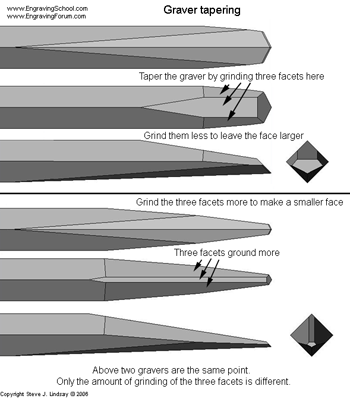Graver Tapering
For
narrowing (tapering) a graver shank, grind however you like to thin them.
Some engravers round the tops. I find it easiest to use three facets
at 10 degrees. One on the top and one either side at 45 degrees from the
top. The more these three facets are ground, the narrower the shank
and the smaller the cutting face will become.
The
pre-sharpened Carbalt gravers with the Lindsay Point that are included
with the AirGravers are not tapered a
great deal so that the face remains larger. This is done because it
is unknown what style of engraving a person is going to use the graver
for. If it is used for heavier bright cutting and the point is
ground down thin it isn't going to work for heavy bright cutting.
Leaving the shanks larger covers all bases since the point can be used for
heavy or fine engraving.

Click to enlarge
Don't get carried
away...
I'm not an advocate of tapering graver shanks down a great deal because of
rigidity concerns.
Think about a graver resembling a tool bit in a lathe. If the
tool bit is thin and positioned far out of the tool holder when a cut is
made, the tool bit will flex and chatter excessively and not cut easily.
A similar result occurs when a long, narrow tapered graver is used with impact power handpieces. The thin graver shank will actual
flex during impacts. It is hard to believe that carbide or high
speed steel will flex, but it does. We can't see it or hear it, but
what will be noticed is that it is more difficult to cut through the metal
compared to a more beefy graver with the same point which does not have as
thin a taper. The cut will be cleaner with less of a bur or no bur
on the side of the cut with a beefy graver too.
It is nice
to keep some smaller tapered gravers laying around, but
don't make a habit of tapering all your graver shanks down thin.
Generally, if a thin shank is always used, it is harder for the point to
cut nicely and there will be less control. Rigidity is the name of the game for clean easy cutting and this goes for
light shading banknote style cuts too. The same goes for how an item
is clamped in a vise. Make sure it isn't flexing or vibrating like
thin practice plates without a backing.
On the other hand, the
reason to narrow the shank is that it reduces the re-sharpening time since
there is less material to touch up when grinding the face and heels.
In addition, sometimes a
thin graver shank or point is needed to engrave next to the edge of something
that wouldn't be possible to get to otherwise.
The style of engraving
you're using a graver for has a lot to do with how small you may want to
taper the shank. Experiment and find what you like best for the
particular job at hand.